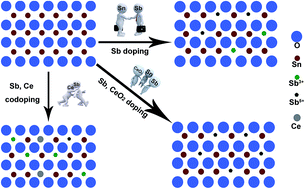Different mechanisms and electrocatalytic activities of Ce ion or CeO2 modified Ti/Sb–SnO2 electrodes fabricated by one-step pulse electro-codeposition†
Abstract
Sb-doped SnO2 electrode was fabricated by the one-step pulse electro-codeposition method, and was modified through either cerium dioxide nanoparticle (nano-CeO2) or cerium ion doping. The results showed that the effects of nano-CeO2 doping and cerium ion doping are quite different. Nano-CeO2 doping shrinks the unit cell volume, improves the degree of crystallinity and refines crystalline grains, while cerium ion doping expands the volume and deteriorates the crystallinity. Nano-CeO2 doping mitigates the surface antimony enrichment and promotes the complete oxidation of antimony so that the majority of antimony oxidation states exist as the Sb5+ state, but cerium ion doping aggravates the enrichment and increases the Sb3+ content. Electrochemical phenol degradation showed that the Ti/Sb–SnO2–CeO2 electrode has a higher degradation efficiency and its kinetic rate constant is 1.46 times as much as that of Ti/Ce–Sb–SnO2. Besides, due to the compact active layer of Ti/Sb–SnO2–CeO2 protecting the titanium substrate from passivation, the accelerated service lifetime of Ti/Sb–SnO2–CeO2 is prolonged, which is 1.28 times as long as that of Ti/Ce–Sb–SnO2.


 Please wait while we load your content...
Please wait while we load your content...